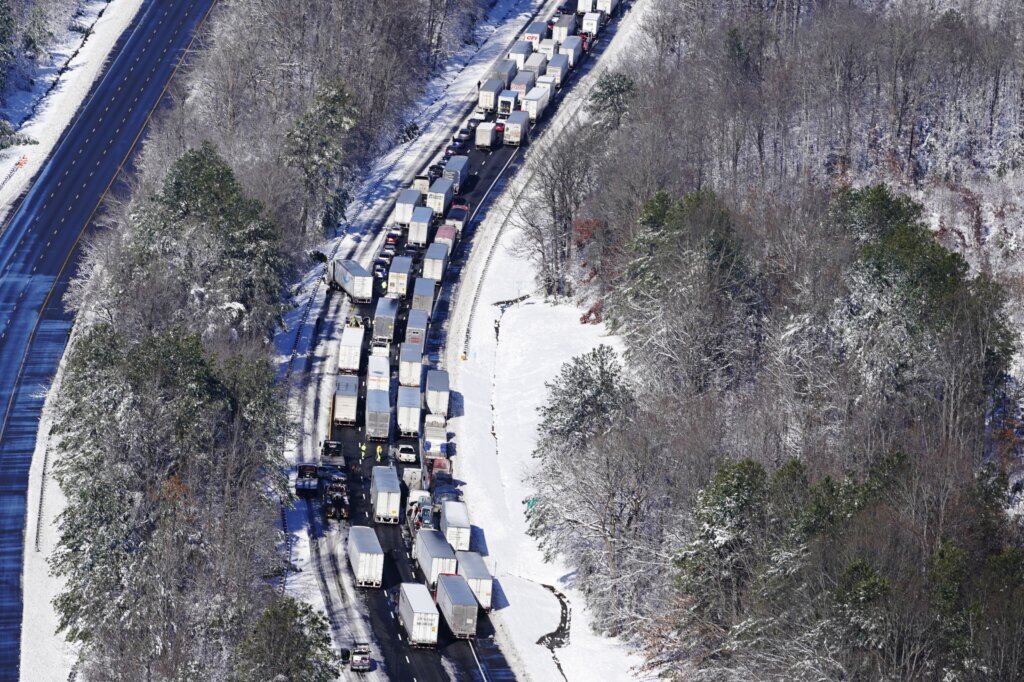
A report on what happened during a winter storm in January that left many drivers stranded for hours on Interstate 95 in Virginia reveals in great detail what went wrong and what can be improved to prevent it from happening again.
The Virginia Department of Emergency Management (VDEM), Virginia Department of Transportation (VDOT) and the Virginia State Police (VSP) requested the after-action report on their decision-making and actions during the weather event on Jan. 3 and Jan. 4, when the D.C. area saw a record amount of snowfall. The storm led to hundreds of drivers being stuck on the road, some for more than 24 hours.
Virginia’s U.S. senator Tim Kaine weighed in on the importance of the report.
The 41-page report found that culminated on the highway near Fredericksburg, with impact extending as far south as Ruther Glen and as far north as Woodbridge.
No deaths or injuries were reported from the gridlock. But the monster logjams fed outrage among motorists, some of them stranded overnight, pleading on social media for help.
The report also addressed key issues for the public, including how the road conditions got so bad, why VDOT didn’t close the highway sooner, why state agency leadership did not understand how bad I-95 was getting and why people weren’t told not to travel on I-95, among others.
How did the road conditions get so bad?
The winter storm on Jan. 3 was the largest snowfall in the area in the last six years, but a day before, temperatures were in the mid 60s.
The report found that the warm weather may have lessened the public’s attention to the messaging warning people of inclement weather and avoiding unnecessary travel.
In addition, the warm weather and the rain days before the storm prevented pretreatment of roads and softened the ground, which later had an impact when heavy snow weighed down trees causing some to fall.
The increase in traffic volume on the road that day can be traced to staff shortages due to the omicron variant that led to flight cancellations over the New Year’s Day holiday, the report said. As a result, travelers coming back from winter break took to the roads.
“Traffic volumes on I-95 around Fredericksburg on January 2 into early January 3 (before the snow) were on average 65 percent higher than on the same days in 2019,” the report said.
It also found that the number of tractor-trailers on Virginia interstates has increased since 2019, due to supply-chain issues and changes in regular commuter traffic — byproducts of the COVID-19 pandemic.
Lastly, the highway in the area has a reputation for being a “traffic hotspot,” in addition to steep, long hills and work zone barriers blocking the shoulders, which the report said affected snow removal.
Why couldn’t VDOT keep up with snow removal?
By Jan. 3, VDOT’s snow response was at Level IV (Level 1 mobilization requires the least resources; Level V requires the most). However, the snow was falling at a rate of 3 inches per hour in the Fredericksburg area, and VDOT slowly got behind.
Other challenges for plows included blocked shoulders, immobilized tractor-trailers, falling trees and downed power lines.
“The rate of snowfall combined with the volume of traffic on the road mean the snow was packed down quickly,” the report said.
Crews removing branches and trees were also soon overwhelmed by the “sheer number of fallen trees, some entangled by power lines.”
And, any additional crews called to help with trees, traffic or towing could not get to the affected areas due to stopped traffic.
Why didn’t VDOT close the highway sooner?
The state’s transportation department and police did not close the part of I-95 because “there were no viable alternate routes available.” Other roads surrounding I-95, were experiencing crashes, downed wires and trees, and unplowed roads, as well, the report said.
VDOT and VSP did not consider an extensive closure as drivers could still drive through one or more lanes, albeit very slowly throughout the day in between bottlenecks, as stops and crashes were cleared.
“Traffic was moving slowly, and VDOT and VSP focused on keeping it that way rather than considering a wide-reaching closure.”
The report said that field supervisors considered the situation to be stable, as long as troopers and tow trucks could reach crash scenes. They also did not push an escalating situation to leadership because those in the field could not see the extent of the growing traffic due to a “broader lack of situational awareness,” the report said.
It was when the wreckers stopped responding that field responders notified the executive leadership for both agencies. Trucking companies stopped sending additional wreckers to gridlocked areas, as they could not easily get through traffic.
VDOT decided to close I-95 on Jan. 4, formally closing it between mile marker 104 and 152 northbound and between mile marker 152 and 136 southbound by 8 a.m.
Why didn’t the state agency leadership understand how bad the conditions were getting?
The report cited the breakdown of traditional methods of information-gathering as a reason for the loss of situational awareness. Power outages caused traffic cameras to stop working in the Fredericksburg area; a VSP Communications Center lost dispatch capabilities for 30 minutes also due to outages and generator troubles; and there were issues with inoperable cell towers. Also for four hours on Jan. 3, VDOT’s 5-1-1 service, which provides real-time traffic information to the public, stopped updating between 7:30 and 11:30 a.m.
There were also staff shortages of field staff due to COVID-19, which meant that staff weren’t able to drive to the interstate to gauge the extent of what was happening.
“While state agencies indicated that signification delays on I-95 had been a problem all day, they did not report that they were exceeding their operational capacity,” the report said.
Why didn’t VDOT open the I-95 express lanes to traffic?
Because opening the I-95 Express Lanes risked blocking them as well, the report said.
VDOT and Transurban, which operates the express lanes, decided to close the lanes to the public, which aligned with “standard snow practices” in the state to ensure that first responders can respond to an emergency, and so VDOT could turn plows around.
Why didn’t state agencies provide direct assistance to stranded motorists?
VDOT decided the best way to help stranded drivers was to clear the incidents on the highway, remove the snow and get traffic moving again. A formal wellness check mission would have diverted resources from its priority.
However, the report said that Virginia State Police troopers were encouraged to walk between cars and check on motorists between responding to incidents.
On Jan. 4, shelters were opened in areas where drivers were still stranded; however, there was no way to move them from their cars into the shelters.
As for activating the National Guard, it takes 12 to 24 hours to mobilize them and they would not have been able to help the stuck motorists.
During the storm, former Gov. Ralph Northam told WTOP that the National Guard is available, “but we haven’t called them to the state.”
Also, National Guard personnel would need to travel to the area on the same roads that were already impassable.
Why didn’t anyone tell people not to travel on I-95, or report how bad traffic was?
VDOT followed common practices for raising awareness of the storm through social media, news releases and media interviews. The report found, however, that follow-on messaging “told the public what the current conditions looked like rather than providing clear direction.”
The passive approach, the report said, relied on the public to access, read and interpret the information and to make decisions on their own travel.
There were also few messages that took into consideration what drivers were feeling and experiencing, leaving many feeling “abandoned” and also frustrated.
What should Virginia do to improve outcomes in the future?
The report concludes that state agencies need to formulate plans to shut down interstates for long periods of time during bad weather.
“While VDOT districts maintain detailed snow removal plans, they do not maintain plans for widespread interstate closure,” the report said.
State agencies should also more effectively use social media to get a grip on the scope of emergencies, and directly communicate with the public about them.
In addition, the state should consider analyzing increased tractor-trailer traffic on interstates and update staffing and mobilization plans.
Lastly, the report said the public has some responsibility to stay informed about road conditions and traffic during storms.
In response to the report, VDOT said its top priority “is and always will be the safety of the traveling public, and as we learn from each event, this report highlighted key areas for us to refine in our winter-weather operations,” Virginia Commissioner of Highways Stephen Brich said.
Gov. Youngkin responds to the report
Following the release of the report, Republican Gov. Glenn Youngkin and members of his administration criticized the former Democratic governor and his office.
Youngkin said in a news release that the report showed “the previous administration’s leadership did not properly prepare or communicate.”
In a letter to Youngkin, Transportation Secretary W. Sheppard Miller III and Public Safety Secretary Robert Mosier claimed there was “almost no apparent involvement” by Northam or his senior staff.
The secretaries wrote that it appeared neither Northam nor his staff considered an emergency declaration. Emails obtained by The Associated Press in the aftermath of the gridlock showed that was not the case and that consideration was given as to whether one was appropriate.
The report was produced by CNA, a nonprofit research and analysis organization that has conducted similar work for the U.S. Navy and local, state and federal government agencies. It said it drew from documents including situation reports, real-time planning documents, news articles, social media, interviews and other sources.
The Associated Press contributed to this report.








